Union Pacific was the second railroad to reach the Pacific Northwest, and it did it in the same way as the Northern Pacific: by building to the Oregon Railway & Navigation Company line and running its trains to Portland over that road. Journalist Henry Villard had gained control of the OR&N in 1875 and parlayed that into control of the then-under-construction Northern Pacific. After completing the latter line in 1883, he lost control of both, and so the OR&N was available for the picking by the Union Pacific.

Oregon Railway & Navigation locomotive 84 hauls what was probably the eastbound Overland Flyer up the Columbia River near the Dalles, Oregon in or soon after 1890. This 4-4-0 had been built in 1890 with 64″ drivers and produced 16,782 pounds of tractive effort. That was fine in the nearly flat Columbia Gorge, but double headers would be needed to climb more than 3,000 feet to the summit between Pendleton and LaGrande, going up some of the steepest grades on the entire Union Pacific Railroad. Click image for a larger view.
In 1884, the OR&N built a line over Oregon’s Blue Mountains to Baker. Union Pacific, meanwhile, incorporated a subsidiary called the Oregon Short Line and began building towards Oregon from Granger, Wyoming. The two railroads met in Huntington, near the Idaho border and 541 miles from Granger. OR&N remained a nominally independent railroad until 1898, but was happy to carry Union Pacific passengers to Portland starting in 1885.
This gave Chicago travelers to Portland a choice of routes: either the Northern Pacific (requiring a change of trains in St. Paul) or the Union Pacific (requiring a change of trains in Council Bluffs and possibly Granger). The UP “short line” route was faster: 108 hours from Chicago to Portland vs. 114 over the NP in 1885. Of course, most travelers didn’t go all the way from Chicago to the Pacific Coast and so didn’t have to spend more than 100 hours sitting on a train.
 We’ve seen that most railroads went from 4-4-0s to 4-6-0s to 4-6-2s as passenger power. UP affiliates owned 4-6-0s that they probably used for passenger trains, especially in the mountains, but I haven’t found any photos of one pulling a passenger train over the Oregon Short Line or OR&N. Ironically, the above locomotive was built nine years before the 4-4-0 in the previous photo so doesn’t really represent more advanced power. Click image for a larger view.
We’ve seen that most railroads went from 4-4-0s to 4-6-0s to 4-6-2s as passenger power. UP affiliates owned 4-6-0s that they probably used for passenger trains, especially in the mountains, but I haven’t found any photos of one pulling a passenger train over the Oregon Short Line or OR&N. Ironically, the above locomotive was built nine years before the 4-4-0 in the previous photo so doesn’t really represent more advanced power. Click image for a larger view.
By 1890, UP had two trains a day between Council Bluff and Portland. UP called the faster of the two the Limited Fast Mail while C&NW called its connection the Overland Limited. It took 81 hours from Chicago to Portland. The second train, which took about 10 hours longer, was called the Overland Flyer on the UP timetable, which connected with the Pacific Express on the C&NW timetable. At that time, there were no through trains from Chicago to the West and C&NW had to compete with the St. Paul Road and other railroads, but the St. Paul Road, at least, ran trains at exactly the same times as the C&NW.
Union Pacific joined the Northern Pacific in bankruptcy in 1893, leading the former to cut one of its Council Bluffs-Portland trains. The former railroad was rescued by Edward Harriman, who also gained control of the Oregon Railroad and Navigation Company in 1898. From then on, the UP, Oregon Short Line, and OR&N were increasingly integrated even if, on paper and the lettering on their locomotives, they remained distinct companies for several more years.
 In the March 1900 issue of the Official Guide, the Oregon Short Line announced a “brand new train” with a buffet, barber, library, and dining car. For some reason, neither parent UP nor partner OR&N acknowledged this train for at least a year, showing they weren’t yet fully integrated. Click image for a larger view.
In the March 1900 issue of the Official Guide, the Oregon Short Line announced a “brand new train” with a buffet, barber, library, and dining car. For some reason, neither parent UP nor partner OR&N acknowledged this train for at least a year, showing they weren’t yet fully integrated. Click image for a larger view.
In 1900, the Oregon Short Line began calling its train from Granger to Huntington the Chicago-Portland Special. This name didn’t find its way onto the Union Pacific or Chicago & North Western timetables until 1901, but it may have been the first UP train to offer through service from Chicago to Portland. To be fair, tt was the same train as the Overland Limited between Chicago and Granger, where cars split off to Portland. Total time for the trip was 71-1/2 hours for an average speed of 25 mph. A secondary train was called the Pacific Express.
In 1906, UP changed the name of the Pacific Express to the China and Japan Fast Mail. This train was about ten hours faster than the Chicago-Portland Special but lacked some of its amenities such as an observation car. In 1910, the Chicago-Portland Special was renamed the Oregon-Washington Limited. It was still slower, however, than the Fast Mail.

In 1906, two-year-old OR&N locomotive 193 poses with the Chicago-Portland Special during its journey up the Columbia River Gorge. Harriman encouraged all of his railroads to buy standardized equipment, and this locomotive is a typical Harriman light Pacific. With 77″ drivers it produced about 29,920 pounds of tractive effort. Though nearly twice as powerful as the locomotive in the first photo above, it would still need assistance going over the Blue Mountains. Click image for a larger view.
By this time, Northern Pacific had speeded up its trains. Going over the SP&S to Portland, the trip was about 20 minutes faster than the UP route. Passengers wanting to go to Seattle or Tacoma saved a lot of time on the NP or GN as UP passengers had to change trains in Portland, which could add ten hours to the trip.
In 1923, UP renamed the Oregon-Washington Limited the Portland Limited. Seven years later, inspired by the success of the Columbine to Denver, it renamed the Portland train the Portland Rose and featured new equipment whose dining and lounge cars were gaily decorated with images of roses. Eventually streamlined, the Rose remained on the timetable up until Amtrak.
